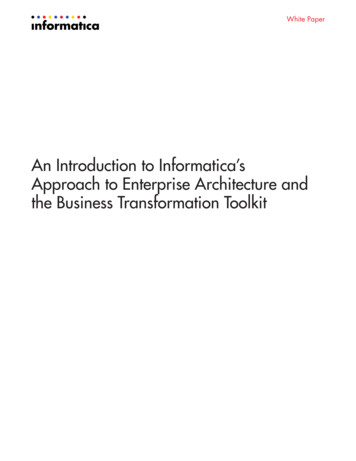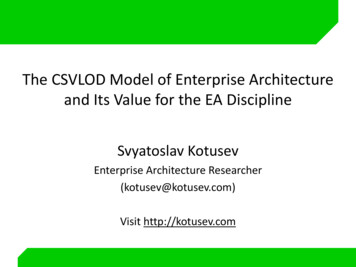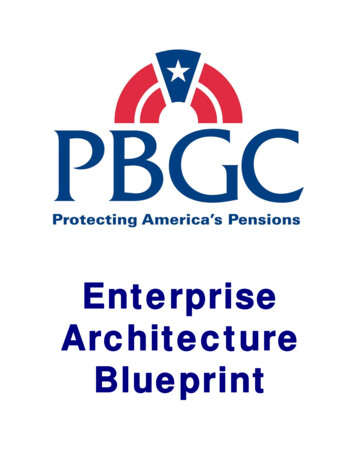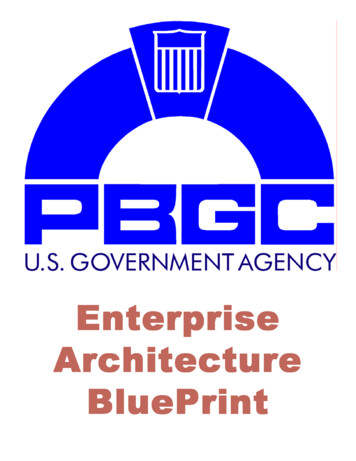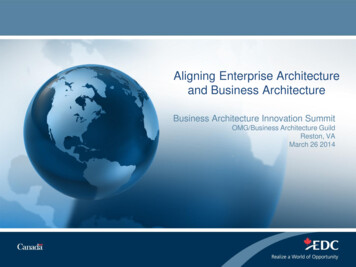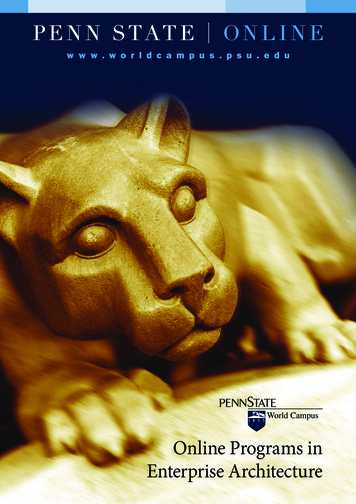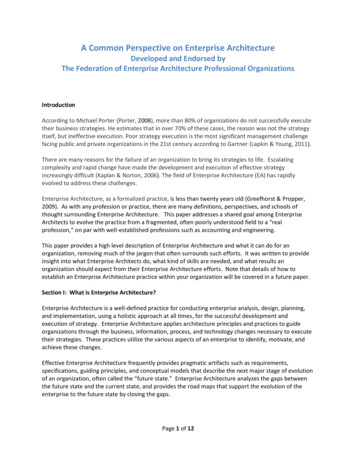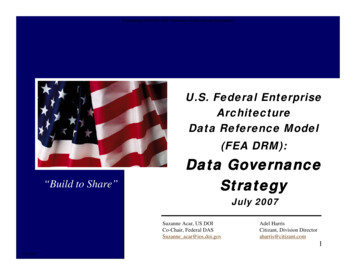
Transcription
Proceedings of the MIT 2007 Information Quality Industry SymposiumThe MIT Information Quality Industry Symposium, 2007U.S. Federal EnterpriseArchitectureData Reference Model(FEA DRM):“Build to Share”Data GovernanceStrategyJuly 2007Suzanne Acar, US DOICo-Chair, Federal DASSuzanne acar@ios.doi.govAdel HarrisCitizant, Division Directoraharris@citizant.com1PG 304
Proceedings of the MIT 2007 Information Quality Industry SymposiumThe MIT Information Quality Industry Symposium, 2007The Federal 3-Pillar Data StrategyFrameworkBusiness &Data GoalsdriveGovernanceThe Rule: All 3pillars are requiredfor an effectivedata strategy.Data StrategyData ls drive; governance controls; structure defines; and servicesenable data strategy.PG 305Special thanks to Laila Moretto and Forrest Snyder, MITRE Corp.2
Proceedings of the MIT 2007 Information Quality Industry SymposiumThe MIT Information Quality Industry Symposium, 2007Federal Data GovernanceData Governance encompasses thepeople, processes and proceduresrequired to create a consistent,enterprise view of an organization’sdata to:GovernanceOversight Promote information sharing Improve confidence and trust indata used in decision-making Make information accessible,understandable, and reusable Reduce cost and duplication Improve data security and privacyPolicy & ProceduresEducation/TrainingProcesses and PracticesIssue ResolutionMetrics/IncentivesData governance is needed to help agencies determine how theywill manage the data relevant for business objectives.PG 306The right information to the right people at the right time!3
Proceedings of the MIT 2007 Information Quality Industry SymposiumThe MIT Information Quality Industry Symposium, 2007Components of Federal Data GovernanceFederal Data Architecture SubcommitteeCommunities of Interest (COI) Collaborative group of stakeholders who require a sharedvocabulary and structure to exchange information in pursuit ofcommon goals, interests, mission or business processEmpowered by President Management Agenda (Federated Lines ofBusiness) and Agency E-Government InitiativesMembers include: Tribal, local, state, federal, public, private and other non-governmentorganizations. Cross functional members including data consumers, producers,program managers, application developers, and data sharinggovernance groups4PG 307
Proceedings of the MIT 2007 Information Quality Industry SymposiumThe MIT Information Quality Industry Symposium, 2007COI ObjectivesCOIs facilitate: Data sharing through common COI vocabularyEstablishment of consistent data management processesPreparation of integrated data access plans or information exchangeschemasDevelopment of information exchange agreementsBrokerage of conflict resolution among data stewardsIdentification of Authoritative Data Sources (ADS)COIs work to resolve common issues affecting their communitiesand develop solutions to promote information sharing.5PG 308
Proceedings of the MIT 2007 Information Quality Industry SymposiumThe MIT Information Quality Industry Symposium, 2007Example: DOI Data Governance BodiesExecutive SponsorDOI E-Gov TeamAppoints Principals,ensures adequate funding, delegates decision authorityin areas of data requirements, standardization, andquality.DOI Data ArchitectDACMaintains & publishes the DOI DRM withPrincipal Data Stewards and Bureau DataArchitects.Promotes the Data Program.(Data AdvisoryCommittee)Principal Data StewardsDOI DataArchitectureGuidance BodyCoordinates proposed data standards with business data stewards & Bureau DataArchitects. Maintains current DOI Data Standards for their respective business line.Submits proposed Data Standards for formal review process. Resolves conflictingdata issues. Champions the use of the official DOI data standards.Bureau Data ArchitectBusiness Line DataPanelAssists in the implementation of the DataProgram among Bureaus in coordination withdata stewards. Maintains Bureau unique datastandards in coordination with data stewards.Business Data StewardData stewards at the Bureau/Office level. Coordinatesimplementation of new Data standards with SME and DBA.Ensures data security & data quality requirements for eachdatastandard.Coordination with ExternalStandards Bodies and otherCommunities of Interest (COIs)Subject Matter ExpertYellow IT perspectivePG 309Green Business perspectiveDatabase AdministratorGray a mixed perspective6
Proceedings of the MIT 2007 Information Quality Industry SymposiumThe MIT Information Quality Industry Symposium, 2007Example: Enabling Net-Centricity –DOD Data StrategyProducerandDeveloperConsumerSystem 1 DataSystem 2 Data.System N DataConsumerUbiquitous Global NetworkMetadataCatalogsEnterprise &CommunityServicesSecurityServices (e.g.,PKI, SAML)ApplicationServices(e.g., Web)ProducerSharedData SpaceMetadataRegistriesDeveloperFrom Producer-centric: Multiple calls to find data Private data – only supports plannedconsumers Data translation needed for understandingwhen pulled from multiple sourcesTo Consumer-centric: Data is visible, accessible, governable andunderstandable Shared data – supports planned and unplannedconsumers Shared meaning of the data enablesunderstandingTransition from disparate networks and within legacy systems to an enterprise 7information environment where known and unanticipated users can access information.PG 310
Proceedings of the MIT 2007 Information Quality Industry SymposiumThe MIT Information Quality Industry Symposium, 2007Example: Recreation One-Stop EGovernment InitiativePresident E-Government InteragencyInitiative led by DOIRequirements: Share data among multiple Federal, State, Localand Commercial partners Share data across multiple business lines Data standards must be easily extensible toaccommodate new requirements Data sharing standards must be translated to adatabase and XML8PG 311
Proceedings of the MIT 2007 Information Quality Industry SymposiumThe MIT Information Quality Industry Symposium, 2007Recreation Community of InterestMembers9PG 312
Proceedings of the MIT 2007 Information Quality Industry SymposiumThe MIT Information Quality Industry Symposium, 2007Recreation One StopChallengesRecreation information it the most sought after information by the e-citizen. There are10too many sources for Federal, state and local recreation information.PG 313
Proceedings of the MIT 2007 Information Quality Industry SymposiumThe MIT Information Quality Industry Symposium, 2007Example: Recreation One-StopGovernance CommitteesCOI: Federal Recreation Providers Recreation Executive Council Members: Deputy assistant secretary level (DOI, USDA, &DOD) Provide strategic perspective Provide adjudication Recreation Managers Committee Members: Senior level Recreation Managers (Smithsonian,DOT, and 16 other agencies) Set priorities Provide requirements and resources Various implementation teams Adoption of data standards Data Stewards Data implementation11PG 314
Proceedings of the MIT 2007 Information Quality Industry SymposiumThe MIT Information Quality Industry Symposium, 2007Example: Recreation One-Stop lTransactionReservationRecreation tion FacilityDescriptiveLocation(Blue Shared railCountryStateHigh percentage of data reuse identified across the COI.PG 31512
Proceedings of the MIT 2007 Information Quality Industry SymposiumThe MIT Information Quality Industry Symposium, 2007Example: Recreation One-Stop DataStandardsRecreation ModelRecreation Data Exchange Standard (RecML) is generated from the13Recreation COI data modelPG 316
Proceedings of the MIT 2007 Information Quality Industry SymposiumThe MIT Information Quality Industry Symposium, 2007Outcome: Data Sharing with BusinessLines and PartnersRecreation One-Stop RecML was developedthrough an interagencycoordinated set ofdiscussions and vettedthrough state and localrecreation partners. RecML has evolved toinclude data such asrecreation areas, sites,events, and activities. Recreation information forfederal, state and localmanaged properties isaccessible from a single site.PG 317Data sharing across business lines and with partners (e.g. AAA) and 14services provider (Reserve America) is done by leveraging RecML.
Proceedings of the MIT 2007 Information Quality Industry SymposiumThe MIT Information Quality Industry Symposium, 2007Questions15PG 318
The Federal 3-Pillar Data Strategy Framework Business & Data Goals. drive. Information Sharing/Exchange (Services) Information Sharing/Exchange (Services) Governance. Data Strategy. Data Architecture (Structure) The Rule: All 3 . pillars are required. for an effective. data strategy. Special thanks to Laila Moretto and Forrest Snyder, MITRE Corp.

